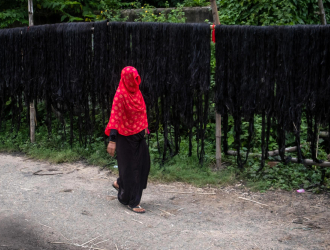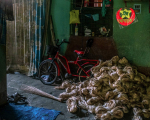As a photographer I try to find subjects showcasing unity and diversity in Indian culture. One such example of communal harmony is witnessed each year in West Bengal during Sharod Utsav, when people from all communities come together to celebrate Durga Puja. However, it is not only the celebrations that is open to all but also the making of the idols that sees participation from the Muslim community, which forms a significant percentage of West Bengal’s population. This syncretic culture is deep-rooted in Parbatipur, a village situated in the South 24 Parganas district of West Bengal, known to supply artificial hair used to decorate the idol of Goddess Durga and other gods and goddesses of the Hindu pantheon.
I came to know about Parbatipur at Kumartuli, the famous colony of idol makers in Kolkata, which is the end point of the artificial hair produced at Parbatipur. At Kumartuli, artists attach the hair as a finishing touch on the idols they make, transforming inanimate clay figures to lifelike divine creatures. I decided to visit Parbatipur with a local friend of mine. The village is well connected to Kolkata on the Santragachi-Amta railway line, the nearest station being Bargachia. While travelling by train one can see dyed jute bales left to dry alongside the railway track. By road Parbatipur village can be reached from Domjur via Amta Main Road. At the village, we observed hair-making taking place in almost every house, even within the premises of a masjid and in the school playground. The villagers were welcoming, and they demonstrated and explained the whole process for our benefit.
According to the villagers, this cottage industry of hair-making was started around 60 years back by one Ekhlakh chacha, who is now very old but still an inspiration to the villagers. Post Partition, much of the jute industry went to East Pakistan (now Bangladesh). Facing shortage of raw material, artificial jute hair was in demand across the state during Durga Puja. Sensing a market, Ekhlakh chacha convinced the villagers to work with him. Having no other industry, villagers agreed, and soon puja organisers began to flock here to buy artificial hair. Now around 50–60 Muslim families and a few Hindu families are engaged in making artificial hair, providing employment to over 900 villagers.
Most villagers do their work in their houses, involving their family members. The raw jute is dyed in the courtyard; dyeing involves chemicals, and the furnace produces toxic fumes, hence can’t be done inside homes. Once the dyed jutes are dried they are distributed among workers to detangle. The process of combing is done in separate rooms or temporary workshops outside the house. The dust generated from brushing the jutes is another health hazard. Sometimes the workers just use pieces of cloth to cover their faces. The village does not have proper sewage or disposal process for the residue chemical waste either.
Due to the introduction of automated machines, manual workers are losing their work. Though the quality of machine-made hair is not at par with their handmade variety, it is cheaper, hence popular in the wholesale market. The cost of raw materials is also increasing every year. The introduction of GST has increased the price further. Earlier hair prepared in Parbatipur was exported all over India, and some also exported to Bangladesh. But now the idol makers of other states and Bangladesh are taking hair from their local hair makers to avoid increasing transport cost and export cost. After almost 60 years, the craft is still a small-scale cottage industry, with no market beyond the idol-making craft.
Because of its dependence on idol-making, the artificial hair-making industry is of a seasonal nature. Hindu festivals do take place throughout the year, but the main demand is just after monsoon, beginning from August, when the idol-making studios get busy with preparation for the festive season. After monsoon they buy raw jute from Hooghly and Nadia districts as jute is only harvested during the monsoon season. The raw jute is dyed and takes long time to dry in the open. Workers have to keep constant vigil on weather because sudden rain extend the drying process. Usually it takes two to three days to dry in sunlight. Women of the household are involved in many stages of work. They clean, comb and separate the jute and roll them on sticks. The finished hair is packaged and shipped to wholesalers in Kolkata and other parts of West Bengal.
Before the pandemic, artificial hair was supplied for an estimated 30,000 idols during Durga Puja festival and other festivals like Kali Puja, Jagadhhatri Puja, Lakshmi Puja and Saraswati Puja. But the business has been badly hit due to the COVID-19 Pandemic this year. Orders have dropped because many festivals have either been cancelled this year or, if happening, there has been a reduction in budget and numbers. The workers associated with hair-making craft have no alternate means of livelihood. With reduced earnings, and very little savings to fall back on, the workers are expecting help from the government in this period of crisis. The health crisis caused by the spread of COVID-19 has added to the already existing health concerns of workers who work without standard protective gear.
Parbatipur, though located close to Kolkata, remains largely unknown and is one of the finest examples of communal harmony in Bengal. Durga Puja is considered a sarbojanin utsav, meaning a festival for all, and the festival is incomplete without the contribution of the Muslim families of Parbaitpur who do not let their religion come in the way of their dedication to their profession.

















